Dia de los Muertos, or Day of the Dead, was yesterday, Friday, November 2. However, the dead are still dead. They don’t need a special day to be so. In fact, they do it every day of the year. Dia de los Muertos is just one day of celebration to honor them.
Dia de los Muertos is not for plants though. Dead plants just get cut down and disposed of. Some get composted. Dead trees get recycled into firewood. These are six pictures of five species of dead plants that I needed to contend with in the week before last.
1. Rhododendron. I really do not know what killed this group of rhododendrons. It is not uncommon for one to die. With all the rhododendrons in the landscape here, a few dead ones get removed annually. However, it is rather disconcerting that a few died all in the same area at the same time. All their dead stems were rather sculptural. They were removed just after this picture was taken. Of the five specie in these six pictures, this is the only species that is not native.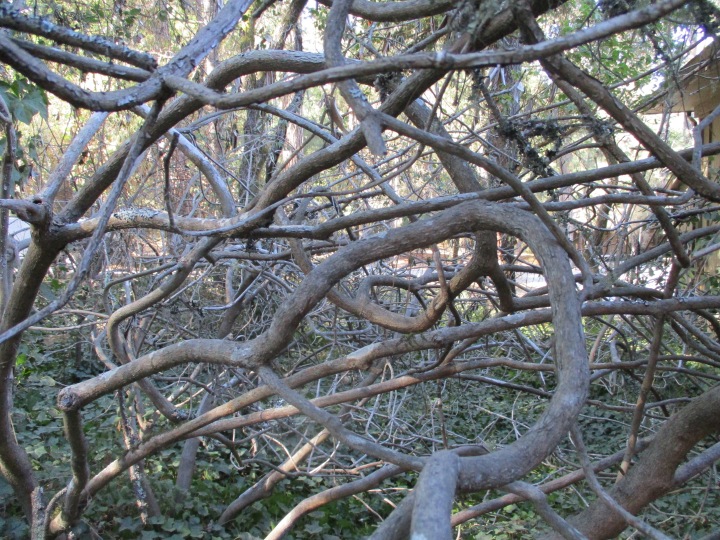
2. Madrone. Bits and pieces of madrone commonly succumb to blight, sort of like fireblight in apple and pear trees. Sometimes, entire trees are killed like this one. It is fire wood now.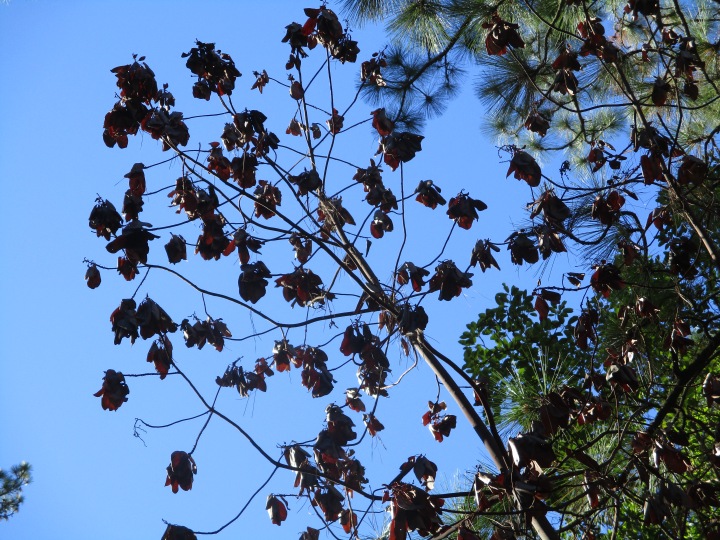
3. Ponderosa pine. The forest does not burn as frequently as it used to before people were here to extinguish forest fires. The lack of restorative fires interferes with regional ecology. Not only is the forest becoming congested with unburned fuel, but pathogens are proliferating in the aging flora and consequently accelerating the deterioration of the forest, which increases the combustibility. It is a natural process designed to correct an unnatural lack of restorative fires, but does not go well for those of us who live here. Ponderosa pines can live for a few centuries. However, in our compromised ecosystem, many succumb to pathogens while still relatively young. This one will need to be removed next year. Once dead, they deteriorate and start to drop limbs within the year.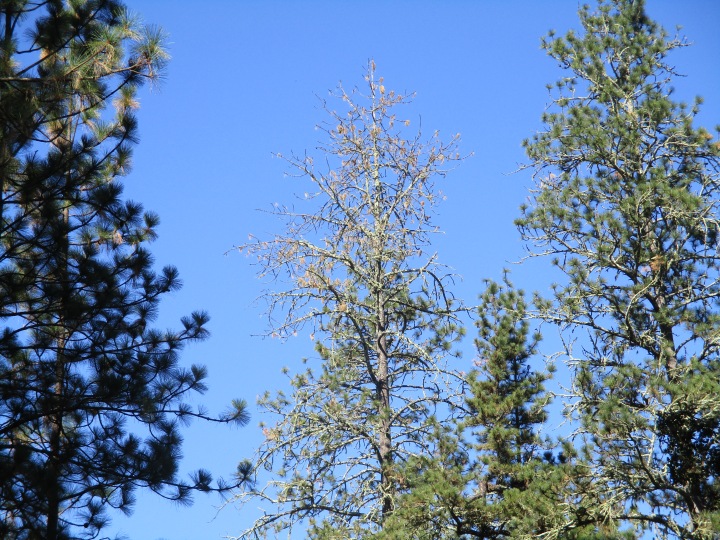
4. Coast live oak. This is one of the most adaptable of tree specie in California. It lives right down to the beach, and into interior valleys, and up the summit of the Santa Cruz Mountains. It does what it must to adapt to the various environments within its range. It often lives in groves of the same, where it is more likely to burn every few decades or so. In spacious valleys, it is often not so social, with individual trees living in relative isolation from their neighbors. Grass fires can burn harmlessly between such trees, allowing them to live for a few centuries. Wherever they are, they develop more trunks than they need. As they mature, subordinating trunks like this one, get shed naturally and harmlessly. It is not as bad as it looks. In the wild, it would rot and fall to the ground as the rest of the tree continues on as if nothing happened. In our landscape, it was cut and taken away.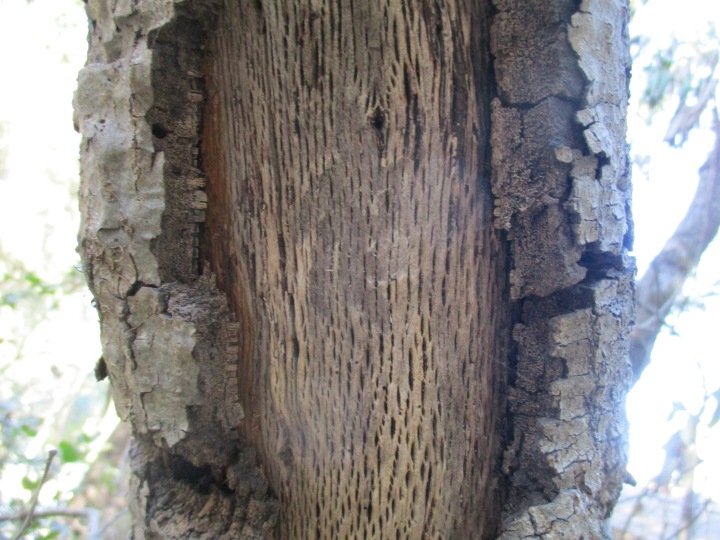
5. Coast live oak. This dead foliage is a bit more alarming because I do not know what caused it. It is probably superficial damage caused by a girdling beetle. I did not look for evidence. Sudden Oak Death Syndrome is a much more serious disease that is all too common here (and a very sensitive subject). Fortunately, this particular specimen is a small and unimportant tree that I would not mind cutting down if it were to succumb. I just do not like to be reminded of how rampant Sudden Oak Death Syndrome is here.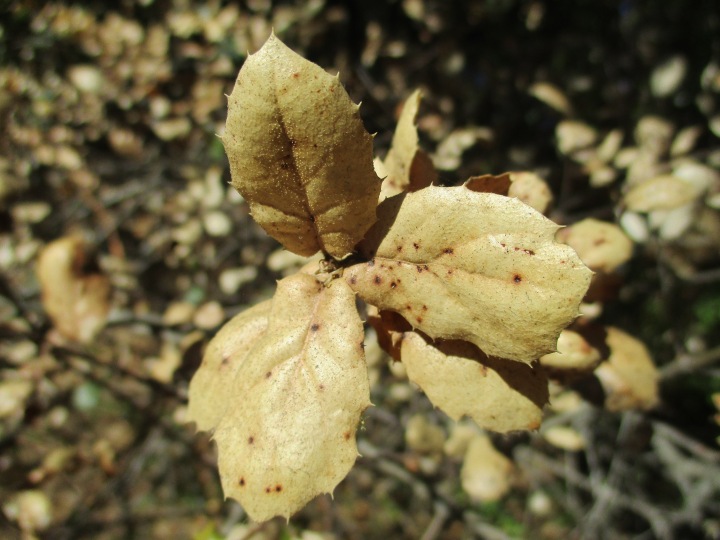
6. Tan oak. This tree really did succumb to Sudden Oak Death Syndrome, Phytophthora ramorum, which is more commonly known here as SODS or SOD. A few adjacent tan oaks that succumbed last year are already very deteriorated and will soon be dropping limbs if not removed over winter. These particular trees are not very important to the surrounding forest. Their removal will actually improve the collective landscape, and give the surrounding redwoods more space to expand. The problem with SOD is that we never know which oaks it will kill next. It kills trees before we know they are infected. There is no remedy.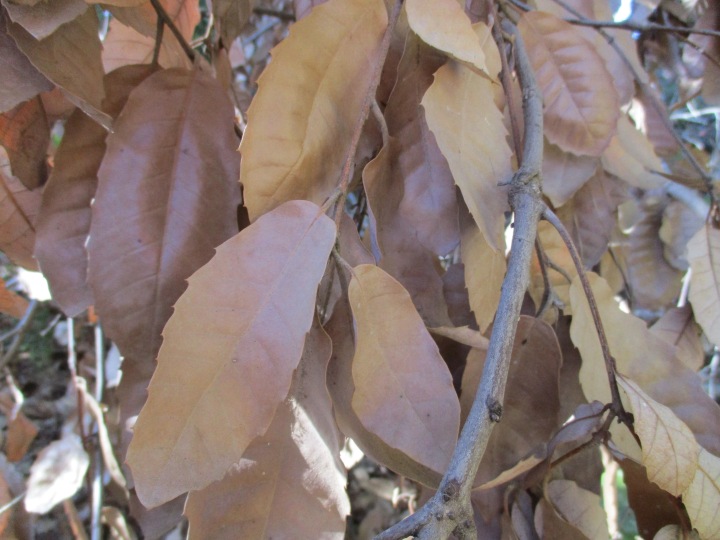
This is the link for Six on Saturday, for anyone else who would like to participate:
https://thepropagatorblog.wordpress.com/2017/09/18/six-on-saturday-a-participant-guide/
Shouldn’t really put a like on this post as it is quite sad when mature trees just die
LikeLiked by 1 person
Well, it is part of nature. It is sad from a human perspective, but the forest knows what it is doing.
LikeLiked by 1 person
Yes I guess it’s best to let nature do it’s thing, but we are certainly messing things up too
LikeLiked by 1 person
Well, that is an entirely different topic. To be brief, it is infuriating to live among redwoods that were clear cut harvested after the Great Earthquake, knowing that the VERY congested secondary growth would benefit from harvesting, but that such timber is too protected to help the forest! In other words, the formerly harvested trees are still alive. They regenerated with many trunks where they had been single trunks. Harvesting of the superfluous trunks would promote healthier growth of fewer but bigger trunks, as the forest should grow. Treehuggers do not want ANY of the trunks harvested, to the groups of trunks press against each other and knock each other over. Even the fallen trunks are wasted on the forest floor. This is one of those rare situations where unnatural intervention could help with unnatural damage to the ecosystem.
LikeLiked by 1 person
Interesting point. Obviously more education needed on tree growth and ecology
LikeLiked by 1 person
I have avoided such topics because they are so infuriating. Treehuggers are ridiculously stupid and unreasonable.
LikeLiked by 1 person
I agree
LikeLiked by 1 person
Although it’s sad to see dead trees, you’ve had the good idea this week. It allows to see another face of Nature (the first picture is really beautiful)
Ps: typo error because you should have written on November 2nd and not October) 😉
LikeLiked by 1 person
Oh gads! I will fix that presently!
LikeLiked by 1 person
I’m interested in your reference to the girdling beetle. I wonder if it is the same as the twig girdler ( Oncideres cingulata) that gives me problems with hickory and pecan trees. Other than burning or trashing the fallen twigs as soon as possible, any suggestions?
LikeLiked by 1 person
Girdling beetle that damage oaks would not be interested in hickory and pecan, although they might be related. Unfortunately, by the time the damage is observed, the target beetle is already gone. I just prune out the damage if it is unsightly and within reach.
LikeLike
These little rascals take about a foot off of limbs; the loss is almost impossible to see from the ground. Given the hickory yield this year, I don’t believe they cause serious damage. They are just annoying.
LikeLiked by 1 person
For us, the damage is superficial, but alarming. The ‘flagging’ that the damage causes resembles that which appears on coast live oaks just before they express other symptoms of SODS, which is very serious!
LikeLike
The photo of the rhododendrons is beautiful. I’m learning more and more about the importance of fire in the natural world. My first experiences were with prairies, but I’m finding that forest managers are equally concerned with finding ways to make use of fire in a way that’s restorative.
LikeLiked by 1 person
Fire is probably more important to more of the ecosystems of California than in other regions. However, the coastal redwood ecosystem is designed to be resistant to fires. They are dense forests that exclude combustible specie. The giant sequoia and other trees that get very old are likewise resistant to fires that burn around or below them. It is fascinating.
LikeLiked by 1 person
It is sad when trees die. SOD is a problem in parts of this country too, Rhododendron ponticum being a carrier, as well as larch. It doesn’t actually harm our native oaks, which is a blessing, but there is a growing list of specimens that it does. There always seems to be another threat to our woodlands and gardens, ash dieback, processionary moth ……
LikeLiked by 1 person
That is one of the many problems with the ‘new’ (as if ‘improved’) Global Economy. Plant material gets sent all over the world. Pathogens that had been confined to their respective regions are escaping into ecosystems inhabited by specie that are lethally susceptible to them. The SOD quarantine put us out of business for a year and a half, and we were blamed for bringing it to California, even though we were one of the last regions to get it.
LikeLiked by 1 person
There really is beauty in death — that rhododendron, sad as it is to lose such a beautiful flowering plant, is absolutely beautiful as you’ve pictured it1 It’s also sad that the oaks and pines are so stressed that they are dying — I hope we will have a restorative winter!
LikeLiked by 1 person
It is not as bad as it looks. Removing the big rhododendron opened the space up nicely. The dead madrone would have been crowded if it were healthy. The dead live oak trunk and dead live oak foliage are superfluous biomass anyway. Even the removal of the dead tan oaks will improve the appearance of the adjacent redwoods, and give them a bit more space. Only the dying pine is a major problem. I hate to lose such a nice specimen that is not bothering anything.
LikeLiked by 1 person
Ah, yes — sometimes cleaning out spaces does open up spaces that wre too crowded. It takes a horticulturist to know what to clear out!
LikeLiked by 1 person
I coulnd’t have done it if the rhododendrons were alive of course.
LikeLiked by 1 person
I love the forensic and morbid tone to this post. Sad, but inescapable.
LikeLiked by 1 person
Oh, it is not as sad as it sounds. As an arborist, it is part of my job.
LikeLike
Interesting post Tony, thanks. All part of the cycle of life.
LikeLiked by 1 person
Thank you. Some disliked all the death. I dislike it too because I must clean it up. However, it is what happens in the forest and landscape.
LikeLike
What a good idea for a post!
LikeLiked by 1 person
Thank you. You might also like the six pictures of what happened to the Gladiolus papilio bulbs next week.
LikeLike